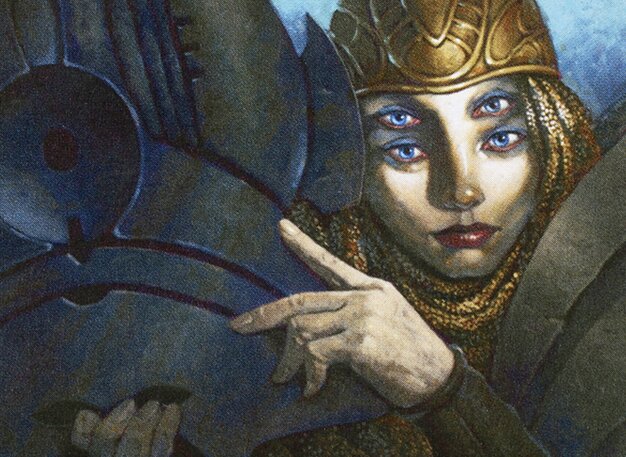 Art by Ron Spears
Art by Ron SpearsThe goal with this cube is to create a limited environment reminiscent of Richard Garfield's original vision of Magic. Before I get into design principles, there are a few fundamentals that will allow us to realize this specific vision:
- All cards must have the same frame (Modern frame from Mirrodin onward). This cube is intended to be played physically, and readability is imperative. Whenever possible, reminder text should be present.
- The cube is intended to be played as a traditional Magic limited set: packs will be formed to be used in draft or sealed. These packs will contain 15 cards (10 common, 4 uncommon, 1 rare). Stickers will be used on sleeves to designate new rarities, ignoring the printed rarity on a card.
- The set is designed to be drafted by up to 8 players with 3 packs each. The set contains 360 cards with the following rarity distribution:
240 commons
- 42 monocolor (10 hybrids), 10 multicolor, 10 gates, 5 lands, 5 artifacts
96 uncommons - 10 dreamscape duals, 3 lands, 3 artifacts, 10 multicolors, 12 monocolors
24 rares - All custom (except for conspiracies), 10 monocolors, 10 multicolors, 4 conspiracies
Now, the guiding design principles:
-
As much as possible, cards should follow the fundamental rules of Magic. Card advantage, creature combat, and threat evaluation should be valued higher than value engines and efficient synergies. To this effect we can make the following rules:
- Permanents should not be able to run away with the game unless your deck is built around them. Take Elder Gargaroth versus Dungrove Elder. Gargaroth is an extremely efficient creature that, unanswered, can continually draw cards, replenish the board, and gain life if you are behind. Although Gargaroth lacks protection, leaving it unanswered creates a double jeopardy where an efficient creature also produces card advantage. By contrast, Dungrove Elder has hexproof. It's harder to remove in a vacuum, but it does not produce card advantage. Dungrove Elder is also a good example of a card that is "unfair", but only in the right deck: this is the standard for permanents in the cube. Another example is Aetherworks Marvel versus Aetherflux Reservoir. Both cards provide a setup and a payoff. However, in the case of Marvel, a non-energy deck could utilize it much more efficiently than Reservoir. Reservoir requires either strong lifegain or a storm strategy to 'get there', Marvel just needs time.
- We can also apply this rule to non-permanents. Heartless Act and even Swords to Plowshares are the gold standard. Efficient removal still requires the use of a card, and leads towards healthy states of threat assessment. What we want to avoid is cards like Bonecrusher Giant that have implicit card advantage, or cards like Noxious Grasp where the card is dead in the wrong matchup. I want to avoid a reliance on sideboarding and "metagaming", as I don't think it's very interesting or leads to fun gameplay.
- Color is very important. Decks are expected to be at least 2 colors, but mono-color strategies are allowed. Multicolor will be treated as a specific archetype and splashing will not be easy. The goal is to prevent a "goodstuff" strategy where all efficient removal can be played in the same deck. As the cube develops, specific attention will be payed to what each color can and cannot do. The goal is to have them in line with "traditional" archetypes.
-
Rather than have 10 set archetypes, the goal is to allow for the development of interesting decks that dip into multiple archetypes or rely on unconventional synergies. This will be accomplished through the rarity system and through a focus on mechanics which broadly overlap with other mechanics. Fundamental aspects of a card should be more important than a critical mass of mechanics: all-star mechanics to this effect are delirium, proliferate, historic, modify, and tribal. We want to avoid infect, day/night, venture, and other mechanics that are overly parasitic and that complicate the board state without sufficient payoff.
-
To this effect, rarity will be re-defined.
- Commons are the majority of cards. They are building blocks which will make up the core of each deck. A deck of all commons should be entirely viable. As an example, the previously rare Dungrove Elder is a common in this set. It's a simply efficient creature that is playable in almost any deck that plays green. Commons represent the best of each color and fit in line with their classic playstyles.
- Uncommons appear slightly more often than normal, with 4 per pack instead of 3. Uncommons should draw a deck towards a more specific archetype. Any non-basic lands are by definition uncommon. Unlike in regular Magic, efficiency has nothing to do with determining an uncommon rarity. Multicolor cards are uncommon, along with cards like Konda's Banner: seeing this card affects your future picks and makes you value legendaries and tribal higher than before. Uncommons are the heart of this cube, and will allow for a lot of unconventional decks. (Konda's Banner is a great example: legendary, artifact, equipment, tribal, and monocolor are all relevant)
- There are only 24 rares in the set. Like uncommons, rares have nothing to do with efficieny. Each rare should be the centerpiece of a deck. Rares enable combos or enable bizzare archetypes that otherwise would not be possible. Since this set is made for draft and sealed, cards such as conspiracies are allowed and are a great example of what rares should be. Emissary's Ploy allows you to change the fundamentals of your deck. Rather than being hyper-efficient threats, rares should inspire you to go wild with your deck and make something unique. Exhume is another potential good example.
Finally, some parting notes on my own specific preferences.
- Art should look good. This goes with the consistency on frames. I like flavor text. I want to avoid things like Rushblade Commander that don't have a classic fantasy composition.
- No planeswalkers. I think they're too efficient and too distracting. This should feel like a cross between classic Magic and a Masters set: complex gameplay made up of simple, iconic parts.
- Simplicity is king. We don't need day/night, DFCs, or unintuitive and overly fluffy cards like Akroan Horse. Gameplay should be snappy and easy to follow.
Tribal: Minor party tribal theme. Party will show up occasionally.
 : Clerics
: Clerics
 : Wizards
: Wizards
 : Warriors
: Warriors
 : Changeling/All
: Changeling/All
 : Rogues
: Rogues
Mechanical Archetypes: Broadly, the archetypes, and five central cards for each.
 : Artifacts and tokens. Arcanist's Owl, Chrome Courier,
: Artifacts and tokens. Arcanist's Owl, Chrome Courier,
 : Legendary aggro.
: Legendary aggro.
 : Madness.
: Madness.
 : Enchantress.
: Enchantress.
 : Surveil/Flashback.
: Surveil/Flashback.
 : Multicolor control. Bring to Light, Worldly Counsel, Skyrider Elf, Sweep the Skies, Exert Influence.
: Multicolor control. Bring to Light, Worldly Counsel, Skyrider Elf, Sweep the Skies, Exert Influence.
 : Artifact creatures. Arcbound Shikari, Master Splicer, Nettlecyst, Tuktuk the Explorer.
: Artifact creatures. Arcbound Shikari, Master Splicer, Nettlecyst, Tuktuk the Explorer.
 : Sacrifice. Ayli, Eternal Pilgrim, Bontu the Glorified, Bloodsoaked Champion, Zulaport Cuthroat, Pawn of Ulamog.
: Sacrifice. Ayli, Eternal Pilgrim, Bontu the Glorified, Bloodsoaked Champion, Zulaport Cuthroat, Pawn of Ulamog.
 : Delirium, creatures in graveyard. Whispers of Emrakul, Deathcap Cultivator, Grim Flayer, Bone Dragon, Exhume.
: Delirium, creatures in graveyard. Whispers of Emrakul, Deathcap Cultivator, Grim Flayer, Bone Dragon, Exhume.
 : Historic. Jhoira, Weatherlight Captain, Sentinel of the Pearl Trident, Mishra's Self-Replicator, Battle of Frost and Fire, The Antiquities War.
: Historic. Jhoira, Weatherlight Captain, Sentinel of the Pearl Trident, Mishra's Self-Replicator, Battle of Frost and Fire, The Antiquities War.
